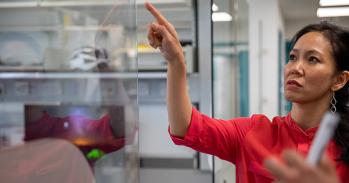
Can better decisions be made about which anticancer drugs to progress to clinical trials?
Can better decisions be made about which anticancer drugs to progress to clinical trials?
Discovering and evaluating anticancer drugs is a billion dollar business. Much effort is put into the discovery of novel drug targets and then elegant chemistry approaches are used to design and synthesise new therapeutics. ‘With the increasing biological understanding of cancer, an increasing repertoire of potential targets has been identified,’ explained Professor Duncan Jodrell, at the Cancer Research UK Cambridge Research Institute (CRI). ‘But, in the past, time and money have been wasted performing large-scale clinical trials on compounds that end up not having a significant impact on cancer. With many more potential drugs, we need to avoid this happening in the future’. Therefore, a major question is which drugs should be progressed to clinical trials?
Professor Jodrell and Dr David Tuveson, also at the CRI, believe that the answer lies in re-designing the way that preclinical studies are performed and in developing more-relevant animal models of the human disease. Essentially, smart drugs deserve smart evaluation. ‘The development of anticancer drugs is therefore likely to have the highest impact when performed at centres that are world-leading in preclinical cancer models, novel therapeutics, molecular imaging and ‘science-led’ clinical application of novel therapies in patients,’ explained Dr Tuveson. ‘All of these components are coming together at the CRI and laboratories close by.’
GEMs of discovery
For many years, mouse models have been an invaluable resource to understand the mechanisms that underpin cancer in human patients. These models have become increasingly sophisticated, starting with xenograft models, in which part of a tumour removed from a patient is transplanted into mice, through to the latest genetically modified mouse (GEM) models, which carry the mutations that have been associated with particular human cancers.
‘One bottleneck for bringing new therapies into the clinic is the extent to which preclinical testing quickly and accurately predicts how well a drug will perform once it enters clinical trials in patients,’ explained Dr Tuveson, who leads the Tumour Modelling and Experimental Medicine group. ‘Our goal is to improve the ability to discriminate between drugs that will have significant patient benefits and those that won’t.’
Dr Tuveson’s particular focus has been on pancreatic cancer and melanoma – two of the most difficult cancers to treat. Despite the fact that we now know which gene is predominantly responsible for each of these types of cancers, patients have a poor prognosis as few treatments are available and many tumours do not respond to them.
Recently, his group discovered a new mechanism that might explain why pancreatic cancer is often resistant to gemcitabine, a commonly used anticancer treatment. Working with colleagues at Cambridge University Hospitals NHS Foundation Trust (Addenbrooke’s) and laboratories in the USA and Europe, the scientists found that resistance to chemotherapy is the result of the pancreatic tumours having a poor network of blood vessels, which makes it harder for drugs to reach the tumour. This result, published a few months ago in Science, may also explain why anticancer drugs targeted at blood vessels (which some tumours have in abundance) don’t work for pancreatic cancer.
‘Working out why some tumours show a disappointing response to chemotherapeutic drugs has enabled us to look at what can be done to overcome this therapeutic intractability,’ said
Dr Tuveson. ‘If the door has been closed to therapy, perhaps we can find a way of reopening it?’ Early studies have shown that a compound called IPI-926, created by Infinity Pharmaceuticals, reduces the amount of tissue surrounding the tumour, allowing greater access for gemcitabine.
Dr Tuveson is also working with colleagues at the Wellcome Trust Sanger Institute to identify genes and pathways that influence cancer development – information that will be used to develop new models that mimic human cancers. The proximity in Cambridge of several drug development programmes – such as the Cambridge Molecular Therapeutics Programme at the Hutchison/Medical Research Council (MRC) Research Centre and groups within the Departments of Chemistry and Biochemistry – will offer broad access to novel therapeutic classes for this work.
Entering a new phase
‘Although the results are extremely promising,’ said Dr Tuveson, ‘these are early days and we need to show that this approach is safe to use in humans before we can consider adding the new compound to cancer treatments.’ To do this, Dr Tuveson is working with Professor Jodrell, who leads the Cancer Research UK Pharmacology and Drug Development Group at the CRI and a closely associated Early Phase Trials Team based in Addenbrooke’s Hospital.
Professor Jodrell is interested in what anticancer drugs do to the body (pharmacodynamics) and how the body handles the drug (pharmacokinetics). ‘These are important determinants of successful therapy since the measurements provide information on whether the drug is hitting the right target. We also learn how long the drug hangs around to do this before it’s metabolised or eliminated.’
An oncology clinic for pancreatic cancer patients is being developed at Addenbrooke’s Hospital and early phase clinical trials are performed in the Wellcome Trust Clinical Research Facility on the same campus. This allows the preclinical studies initiated in CRI laboratories to be translated into clinical benefits for patients. Trials will be available for patients with both early and advanced disease. ‘We will be looking for biomarkers that can identify which tumours will respond to a particular treatment, as well as markers that demonstrate early that the treatment is working,’ explained Professor Jodrell. ‘The goal is to identify which patients will benefit from drugs, and to get more information at an earlier stage to inform those ‘go/no go’ decisions for progressing a drug through to later-phase clinical trials.’ For both the preclinical and clinical studies, novel imaging techniques devised by Professor Kevin Brindle and Professor John Griffiths at the CRI may provide instantaneous assessment of response to treatment. In patients, these non-invasive imaging tools will hopefully maximise the information accrued, yet avoid the discomfort for patients of undergoing serial biopsies to obtain tumour tissue.
Information from the preclinical models of pancreatic disease developed by Dr Tuveson will soon be integrated into clinical trials. A clinical trial protocol will commence in Cambridge in early 2010 to test novel combinations of gemcitabine and other drugs. Collaboration with Dr Adrian Mander, leader of the MRC Biostatistics Unit Hub in Trials Methodology Research in Cambridge, is providing statistical approaches to maximise the information derived from the trials.
Anticancer cocktails
The unique mirroring arrangement between preclinical models and clinical trials that is being created in Cambridge holds great promise for moving towards individualised therapy for cancer patients. Novel and established drugs can be tested quickly and effectively to work out the appropriate combination that will overcome lack of response to treatment. ‘It’s now possible to imagine the day,’ said Professor Jodrell, ‘when each patient is treated with a personalised cocktail of drugs that takes account of the specific attributes of their cancer.’
For more information, please contact Dr David Tuveson (david.tuveson@cancer.org.uk) and Professor Duncan Jodrell (duncan.jodrell@cancer.org.uk) at the Cancer Research UK Cambridge Research Institute/Li Ka Shing Centre.
This work is licensed under a Creative Commons Licence. If you use this content on your site please link back to this page.





